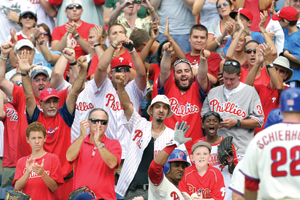Major League Baseball’s continued attendance rise in 2012 showed not only a growing fan affection for the sport but also sharp reductions in the traditional lag between winning and ticket-sales spikes.
The league ended the regular season with attendance of 74.86 million, up 2 percent from a year ago (see MLB Turnstile Tracker). The increase was shy of the 3 percent to 5 percent bump projected by MLB Commissioner Bud Selig before the season, but it nonetheless represents MLB’s highest attendance count since 2008. It also marks the first two-year run of growth since 2006-07 and the highest year-over-year percentage increase since the sport’s record-setting year of 2007.
 |
The Philadelphia Phillies led individual clubs for the second straight year with a home attendance of 3.566 million.
Photo by: GETTY IMAGES
|
Perhaps even more meaningful was the attendance growth among many of the clubs bound for the postseason, driven in part by the introduction of the second wild-card slot in the National and American leagues. This season featured the dramatic on-field rise of several upstart clubs making either their first playoff appearance in their present city or a return after many dormant years, notably Washington, Baltimore and Oakland.
Rather than having to wait a year for increased ticket sales to provide a return on that success, as has historically been the case, clubs saw meaningful gains this year. Eight of the 10 playoff teams posted an increase in total attendance over last year, and while the New York Yankees and San Francisco Giants posted slight declines, they still ranked second and fourth, respectively, among all clubs in attendance.
Among the teams showing the largest spikes compared with 2011, four were playoff teams; also in that group were Miami, playing in a new ballpark, and the Los Angeles Dodgers, now under new ownership.
Similarly, the three clubs with the largest aggregate declines — Houston, Minnesota and Colorado — posted poor second halves of the season.
“Typically, you do have that lag, but we’ve really been preparing for what happened this year for more than two years,” said Andy Feffer, Washington Nationals chief operating officer. The Nationals, winning their first NL East division title since relocating from Montreal after the 2004 season, ended 2012 with an attendance of 2.37 million, up more than 430,000 from a year ago.
“All the many things we did around the ballpark with the new amenities, the free concerts, the revamped promotions, creating additional value and so forth, it was all designed to help put us in a position to take off very quickly when the team came together as we thought it would,” Feffer said.
Some of the tightening correlation between on-field performance and attendance also owes to the maturation of the ticketing industry through continued advances in areas such as the secondary market and dynamic pricing.
MLB attendance is a critical indicator of the health of the league and the sports industry at large. Ticket sales represent baseball’s largest individual revenue source, and the sport has more ticket inventory to sell than any other league.
“We’re right in the zone of where we’d thought we’d be,” Selig said. “There aren’t necessarily any big surprises, but these are still very big, very healthy numbers that reflect the tremendous popularity of the sport.”
Unlike last year, which finished with a historically strong September kick, MLB’s 2012 attendance increase steadily crept down in the season’s second half. The league in June was tracking more than 7 percent ahead of 2011, as early ticket sales were surging even beyond Selig’s estimates. But after the All-Star break, the gains winnowed down on a week-to-week basis. Selig said some of that slowdown was expected, particularly with the conclusion of 2012’s interleague play in June.
Next year, interleague play will be continuous throughout the season, because of Houston’s realignment to the American League, bolstering MLB optimism for further attendance gains next year.
The Philadelphia Phillies led individual clubs for the second straight year with a home attendance of 3.566 million. The Tampa Bay Rays, despite a fifth consecutive winning season, ranked last with a total of 1.56 million, highlighting the club’s continuing problems playing at Tropicana Field.




